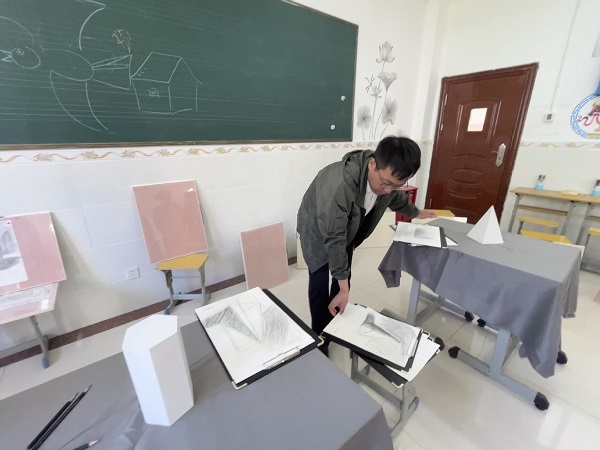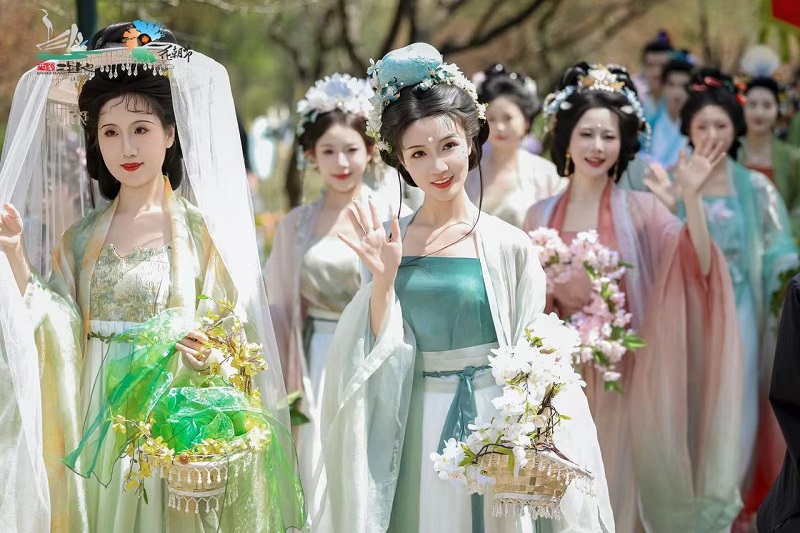Hangzhou teacher brings art and inspiration to Tibetan boarding school

Wu Pengbo, an art teacher from Hangzhou of Zhejiang province is sorting students' painting at the Gala township of Garze Tibetan autonomous prefecture, Sichuan province. [photo by Luo Wangshu/CHINA DAILY]
Education aid initiative
As part of the support initiative between Shangcheng District of Hangzhou and Garze Tibetan autonomous prefecture, Wu will spend two months at the school.
Although his time is brief, he hopes to make the most of it by helping the school utilize the art room effectively and encouraging students to manage the studio independently.
"Students who truly love painting will come to the studio during their free time," Wu said.
Wu wants to convey two key messages to the students: that painting can benefit their future, such as for higher education, and that painting is a joyful activity.
In the art room, he has divided the space into two areas — one for free drawing and one for sketching instruction.
The art room is well-equipped with plaster busts for basic sketching, as well as an assortment of painting tools and supplies in the adjacent storage room.
Wu believes that art can transform individuals and is already seeing changes in his students.
"The students are eager to come and are very happy," he said, adding that the students follow classroom rules willingly and require no disciplinary intervention.
Despite most students having no prior foundation in art — 80 percent of whom have never drawn under professional guidance — Wu believes they can reach the same level as students in Hangzhou.
"The children here are very imaginative. I hope that even after I leave, they will continue to find joy in painting," he said.
Sangzhu Lhamo, a shy 13-year-old sixth grader, is particularly fond of the art room. Her home is about 150 kilometers from the school, a four-hour drive away, so she spends most weekends at school.
"I really like going to the art room. Painting is a happy thing," she said.
"Previously, the school had no dedicated art teacher, and other teachers, who were not professionally trained but served as substitutes for art teachers, sometimes lacked confidence," Principal Mao said.
He plans to have those teachers learn art education from Wu so they can continue guiding students after he leaves.
"All students have one art class per week. I also support Wu's suggestion to let students manage the art room themselves," the principal said.
The principal further noted that students have expressed their fondness for Wu and their enjoyment of painting.
"Students told me they didn't know how to start drawing before. Wu has taught them not only how to appreciate art but also how to begin creating it," he added.
Wu's arrival in Garze is part of China's educational aid policy for the Xizang autonomous region and other Tibetan prefectures in the provinces of Sichuan, Gansu, Qinghai, and Yunnan, aiming to boost education quality and close gaps between Xizang and other parts of China.
The head of the Education Bureau of Shangcheng District, Xiang Haigang, said they have sent their best teachers for educational support.
"I have never considered art education as a secondary subject. In the journey toward modernizing education in China, art, sports, and labor education are all extremely important. Deploying our outstanding teachers to relatively underdeveloped areas brings significant improvements and meets fundamental needs for comprehensive development," he said.
In developing areas, there is often a shortage of teachers for so-called secondary subjects. Such education allows children to experience and discover beauty, helping them understand what constitutes a good life in the future, which is crucial in the educational process, he said.
He also believes that art teachers can help Tibetan students better record and pass on their ethnic culture through art. "Additionally, it helps children recognize that Tibetan culture is also a part of Chinese culture," he said.
Xiong Bingqi, director of the 21st Century Education Research Institute, noted that art education is lacking in underdeveloped areas in China, with a shortage of teachers and insufficient attention from local governments.
Having teachers provide support in these areas is beneficial, but the extent of its effectiveness depends on how the teachers approach their work, Xiong said.
A true family
Though Wu has been at the school for less than a month, he has forged strong bonds with students and teachers.
"I have gained immensely from this experience. I am very happy here, not only with the professional achievements in art but also in my interactions with colleagues and students. They are genuinely wonderful and simple people, and spending time with them has been very joyful," he said.
Wu has also found inspiration for his artwork. "I have always been interested in Tibetan culture. Although I had lived in Xizang areas before, this is my first time in a school setting. My understanding has deepened significantly, which has been very helpful for my painting. I am creating works related to this experience, and the biggest realization is that we are very similar. Han and Tibetan people truly are one family; there is no real difference. Even in terms of appearance, I feel quite similar to them now, and communication is smooth without any barriers," he added.
-
Xixi Wetland invites visitors to Huazhao Festival
March 25, 2025
-
Hangzhou sets standard for concert hosting
March 19, 2025
-
What is making Hangzhou the new tech powerhouse of China?
March 10, 2025
-
Inside Hangzhou: China's high-tech dream factory
March 12, 2025



